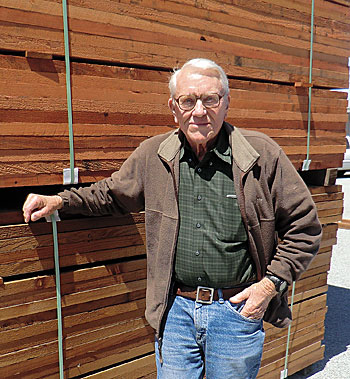By Noel Smith

Bud’s family started the Big Creek Lumber Co. in 1946 and the company has been on the cutting edge of responsible lumbering for almost 70 years. Bud, his father Frank Sr., and his brother Frank Jr. all served in WWII. Frank Sr. was a Seabee (CB – Construction Battalion) serving in the Pacific war zone for three years building military facilities and was on Okinawa while Bud was in the Navy serving on the aircraft carrier Antietam (CV-36) when the war ended.
With the end of the war the three McCrary’s along with Frank Sr’s brother in law, Homer Trumbo, started Big Creek Timber Co. With $7500 in War Bonds and savings, using surplus military equipment – which they modified to fit their needs – a homemade mill, axes and crosscut saws, Bud and the new company took their first contract to log his uncle’s land on Scott Creek. The family had been living on the coast in the Swanton area since 1864 and had purchased the family property of 147 acres along Big Creek in 1869 which they still own today.
Forest management and responsible logging became local issues in the 1950’s largely due to the efforts of Alice Earl Wilder of Ben Lomond. Alice became known as the county’s “Sixth Supervisor” and encouraged the county to tightly restrict logging. Bud was already interested in how to preserve our forests for the future while also keeping his lumber company profitable, so he worked hard using his forestry knowledge and experience to find compromise with environmentalist organizations such as the Sierra Club.
Forestry standards that he helped develop and introduce into logging have been used as industry and governmental standards since the 1960s and the company he helped found is still a leader in looking to the future of our forests and how to sustain them.
Bud is now looking to the future of transportation as his next challenge in improving our lives while protecting the environment. Since 1998 his abundant energy has been focused on developing a personal transport system he calls “QwikLane.” He is so dedicated to the idea that he has registered ten patents on various aspects of the concept, has a website (www.kwiklane.com) complete with videos demonstrating the system and how it would work, and has financial figures that justify its economic viability.
The genesis of his QwikLane idea was seeing trucks stuck in traffic. Bud’s question was, “How can we separate trucks from cars on our roads so trucks can meet promised delivery times?”
In order to answer this question, Bud developed the QwikLane system with:
- A car that would drive at 100 feet per second (68mph) while on the roadway
- A computer that would take control of the car while driving on the roadway, that would keep separation between the cars so they would travel safely at that speed, and that would control them while they safely enter and leave the roadway
When Bud first conceived of his personal transport system:
- Easily installed prefabricated roadways hadn’t been designed… now they have (He had them designed!)
- Cars didn’t drive and steer themselves… now they can (The Google Self-Driving Car among others)
- Communication systems allowing an external computer to control the speed and separation of cars weren’t readily available… now they are (ITS, DSRC, etc.)
To show some of the detail he has developed for this system, the roadway Bud had designed for QwikLane is prefabricated to be installed over the rights of way of existing freeways, roads and streets.
Using 60 foot sections of roadway on pre-installed columns and setting each new section from previously laid sections would require a fraction of the time and cost of normal freeway construction without disrupting traffic. It seems that technology has caught up to Bud’s QwikLane idea making the concept something for our planners to seriously consider.
QwikLane shows that Bud McCrary’s enthusiasm and his thought processes haven’t slowed down. Log on to www.kwiklane.com to see his plan for the future and visit www.big-creek.com to see just some of what he has already accomplished in his 88 years.